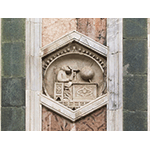Giotto's Bell Tower
Appointed master-builder of the Opera del Duomo, Giotto set hand to building and decorating the Bell Tower in 1334. At his death in 1337, he was replaced by Andrea Pisano who was in turn replaced by Francesco Talenti who completed the building in 1357.
The sculptural cycle that adorns the Bell Tower depicts a sort of Medieval encyclopaedia of knowledge, translating into images the philosophical and theological thought of the epoch (the original sculptures are conserved in the Museo dell’Opera del Duomo). The decorative programme recounts the destiny of man, presented as a process of civilisation: created from earth, man succeeds in dominating the world by learning technology, the control and exploitation of resources, intelligence and speculation which make him worthy of Redemption. Thus the hexagonal relievos of the first register depict man’s creation and the discovery of the fundamental technologies: the "mechanical arts" enabling him to dominate nature, and the arts inherent to the organisation of society. The rhombus-shaped panels of the upper register depict the "liberal arts" aimed at theoretical speculation, and the virtues which make man worthy of salvation, as alluded to in the large sculptures of the top row.
Science and technology occupy a prominent place in the Bell Tower relievos with the allegorical depictions of astronomy, medicine, the building art, weaving, navigation, geometry and arithmetic. Though human activities are presented by means of the personification of their mythical inventors, whether biblical or classical, the relievos offer a cross section of life in Florence in the 14th century. Thus the panel dedicated to medicine depicts the consulting room of a doctor in the Middle Ages: several women wait to give the doctor a matula, a bedpan containing urine to analyse, formed by a vase of thin, light glass, enclosed in a straw casing, with a lid and handle. The iconography, especially medieval, often depicts, as in this panel, a doctor in the act of observing the urine contained in the matula against the light, thus emphasising the importance of analysing real data for a correct diagnosis. For this reason, the matula became an emblem of physicians.
The Bell Tower relievos devote a lot of space to astronomy. The first relievo of the southern side (towards via de’ Calzaiuoli) depicts Gionitus, the mythical inventor of Astronomy, intent on observing the height of the celestial bodies using a quadrant, a scientific instrument that owes its name to its typical shape, the quarter of a circle. Also worthy of note are the rhombus-shaped panels on the western side of the Bell Tower, which depict the celestial bodies of medieval astronomy.
****************************
Texts by Graziano Magrini
English translation by Victor Beard
Last update 26/gen/2008




